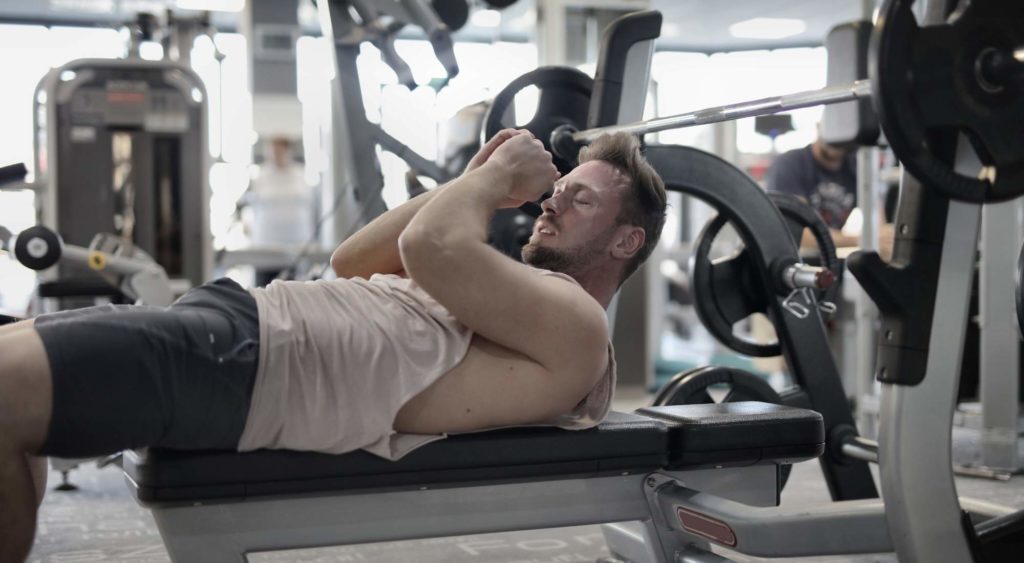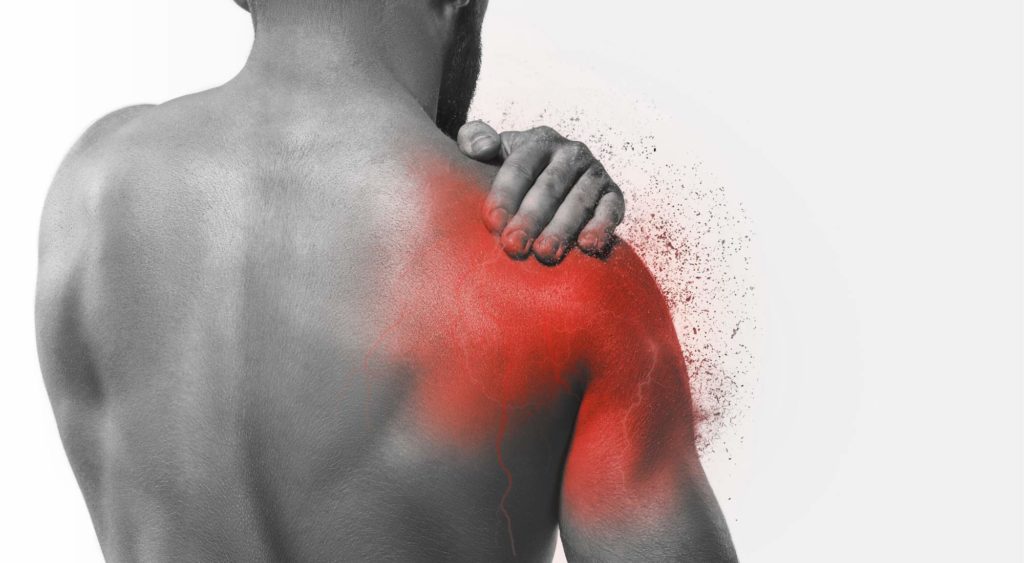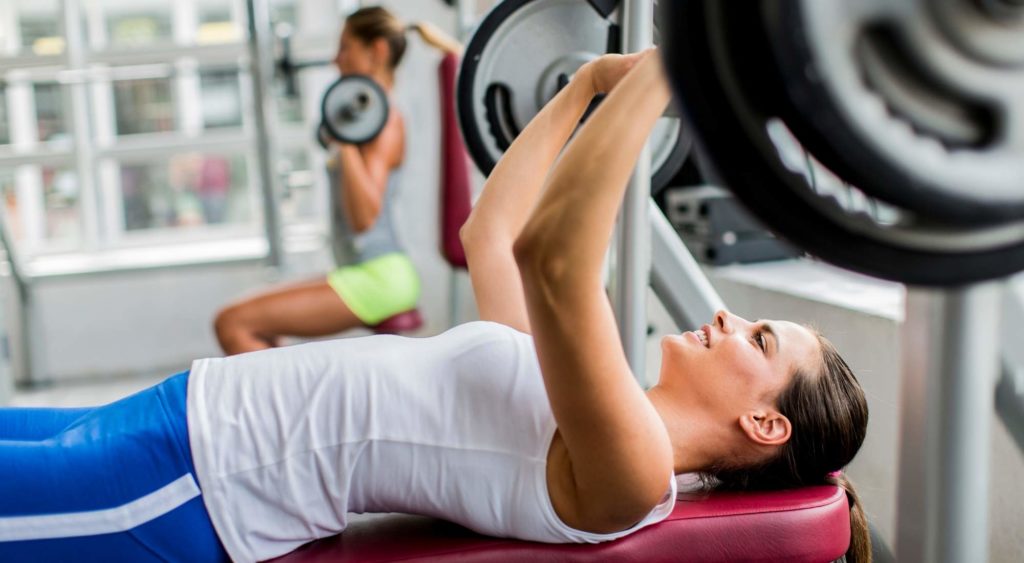
Weight training is important, but it doesn’t always feel great.
It’s tiring. It’s tough.
You’ve heard the phrase “feel the burn,” right?
After all, you’re building muscle.
But feeling uncomfortable during a tough workout is one thing. Pain is another.
If you’re feeling shoulder pain when you hit the gym, specifically when you bench press, you’ve come to the right place. Read on to learn about:
- Types of shoulder pain
- Common causes of shoulder pain during bench press
- How to avoid shoulder pain during bench press
- How to heal
You should be able to pump iron without pain. And you can … IF you know what’s causing the aches and how to fix it.
Contents
Shoulder Pain During Bench Press
Front Shoulder Pain Bench Press
Shoulder Blade Pain Bench Press
How To Address Shoulder Pain After Bench Press
3 Common Causes For Shoulder Pain Bench Press
Shoulder Pain During Bench Press
The bench press. It’s an incredibly effective exercise for developing upper body strength but only when it’s done correctly.
Think for a minute about when you lay down to do the bench press.
Maybe you lay there for a few seconds in dread before reaching up for the bar because you know it’s going to hurt. But you press on.
First things first, can you identify when you feel the pain? Is it:
- When you lower the bar to your chest
- When you press the bar up
- When your arms are extended
It’s also important to pinpoint specifically where the pain is coming from:
- Front shoulder
- OR
- Shoulder blade
It’s one thing to know you’re experiencing shoulder pain, but the shoulder is made up of tendons, ligaments, and several muscles. When it comes to your pain, digging into the where and when is essential to determining:
What’s happening and how to fix it

Front Shoulder Pain Bench Press
Let’s say your pain is in the front shoulder.
Think again about laying down to bench press. If it’s helpful, lay down on the floor or a bench. Imagine you’re about to lift the bar. Are your shoulders or upper arms rounded forward?
This is a red flag and could be causing excessive strain in your rotator cuff.
A quick adjustment—before you press the weight up, roll your shoulders down and away from your ears. Then retract your shoulder blades by imagining squeezing them together.
Still laying down, extend the imaginary bar above your chest. Where are your hands? There’s a chance your grip is either too narrow or too wide.
A grip that is too wide increases stress on the shoulders. A grip that is too narrow can increase stress on the elbows.
Another easy modification—grip width should be no wider than 1 and a half times your shoulder width.
Shoulder Blade Pain Bench Press
Maybe your pain doesn’t hit the front of the shoulder. Maybe instead, you feel pain in your shoulder blade, or between the shoulder blades. This is sometimes referred to as interscapular pain.
This pain presents in the upper part of the back between the shoulder blades and can feel like:
- Dull pain
- Shooting pain
- Overall soreness
Common culprits of shoulder blade pain include:
Heavy lifting
Poor posture
Muscular imbalance
Stretching can also help relieve scapula pain.
How To Address Shoulder Pain After Bench Press
Maybe your shoulder feels fine while you’re bench pressing.
Maybe the pain only kicks in after you’ve benched, and you’re already home from the gym. You might not even experience the pain until the next morning.
If that’s the case, you’ll want to consider these things:
- Mechanics of the bench press
- How much weight you’re lifting
- Bench press form
The goal is to eliminate shoulder pain after benching.

Look At The Mechanics Of Shoulder During Bench Press
When performing the bench press, you’ll want to follow these basic instructions:
- Lie on a flat bench, facing up and gripping the barbell slightly wider than shoulder-width apart.
- Focus on ensuring your shoulders are rolled back and down, retracting your shoulder blades by pinching them together.
- Press your feet into the ground and your hips into the bench as you lift the barbell off the rack.
- Slowly lower the barbell to your chest, bending at the elbows.
- Once the barbell reaches chest height and your elbows dip slightly below the bench, press your heels into the ground to raise the barbell back up.
- Return the barbell to the starting position, elbows extended but not locked.
When identifying the source of shoulder pain, it is necessary to look at the mechanics of the shoulder, specifically the scapula during the bench press exercise.
When preparing to lift the bar, the scapula (shoulder blade) must be retracted. Think about the shoulder blades being pressed together as if you’re trying to get them to touch. Retracting the scapula provides stability to the shoulder.
How Much Weight Is Being Used?
- How much weight are you lifting?
- If you become too focused on “making gains,” you could be setting yourself back.
- Don’t fall into the trap of trying to impress others with big numbers. More does not equal better when it comes to lifting.
- Don’t push aside proper form and technique in order to lift heavier.
Lifting weights that are too heavy can cause serious muscle and joint damage.
It’s safer and more efficient to lift a lighter weight and focus on form.
Bench Press Form
Speaking of—if you’ve spent any time in a weight room, you’ve probably heard trainers preaching about the importance of proper form. You may have even noticed blatantly bad form.
Personal trainers and physical therapists put so much emphasis on correct form because it helps to:
Prevent injuries
Improve effectiveness
Increase efficiency
There are a few common mistakes lifters make when performing the bench press. These include:
Elbows flared out
- Improper grip width (too wide or too narrow)
- Wrists rolling back
- Resting the bar on your chest
- Dropping the bar to one side
- Raising body (neck, head, feet, butt) during lift
Fitness coaches and certified physical therapists at In Motion O.C. can ensure you are using correct form and posture, and help you bench press without shoulder pain.
In addition to helping you prevent pain and injury, following proper form instructions from the professionals at In Motion OC can help bring your strength to new heights (or weights).
After all, if you’re spending your time and energy lifting weights, you might as well get the most bang for your buck.
3 Common Causes For Shoulder Pain Bench Press

There are a few common causes for shoulder pain during or after bench press:
AC Joint Dysfunction
Labrum Irritation
Rotator Cuff Dysfunction
If you’re not in the healthcare or fitness industry these words might not mean much to you, so we’ll break down exactly what each medical term means, and how these specific injuries and irritations are often caused.
AC Joint Dysfunction
AC stands for Acromioclavical. AC joint dysfunction is an injury to the top of the shoulder. More specifically this is where the shoulder blade (acromion) meets the collarbone (clavicle).
There are two common causes of these types of injuries:
Traumatic AC joint injury
Also known as a shoulder separation, this is most often caused by falling directly on the shoulder or taking a direct blow to the shoulder.
Overuse AC joint injury
This type of injury is common in those who lift heavy weights (specifically during bench press or military press exercises) as well as those with jobs requiring physical labor and lifting of the arms overhead.
Labrum Irritation
Do you feel (and even hear) a clicking or popping when you lift your arms overhead? There’s a good chance it’s irritation of your labrum, possibly even a tear.
What does that mean?
Don’t worry if you don’t recognize the term “labrum” from your high school anatomy class. Here’s a refresher—the labrum is a piece of fibrocartilage or tissue attached to the rim of your shoulder socket. Its job is to keep the ball of the joint in place.
Labrum irritation or a labrum tear usually comes with significant pain. Symptoms to be on the lookout for include:
- Deep, achy pain
- Pain during overhead motions
- Popping, clicking, or grinding in your shoulder
- Shoulder weakness
- Decline in athletic performance
Rotator Cuff Dysfunction
Your rotator cuff is a group of four muscles and tendons that stabilize your shoulder joint and allow you to lift and rotate your arms.
Most rotator cuff tears are a result of wear and tear in the shoulder joint over time.
Symptoms of a rotator cuff injury can include:
- A dull ache deep in the shoulder
- Pain that disturbs sleep
- Difficulty raising arms/decreased range of motion
- Arm weakness
How To Heal Shoulder Pain From Bench Press
Shoulder pain is common and affects 18-26% of adults at any given time.
Treatment for shoulder pain depends on the severity of the injury.
While surgery is sometimes necessary, doctors will usually recommend more conservative methods for relief when possible. These methods may include:
Rest
When shoulder pain develops it’s a good idea to take a few days off and avoid upper body lifting.
Cold compresse
Periodic icing or cold compresses help to reduce swelling and numb sharp pain.
Anti-inflammatory medicines
Taking ibuprofen naproxen can provide pain relief for mild injuries.
Stretching
A shoulder focused stretching routine can:
- Relieve pain and tightness
- Improve flexibility
- Increase range of motion
Physical therapy – Many people with shoulder pain can find relief, manage their symptoms, and prevent future pain when they return to activities with physical therapy. Highly trained physical therapists can create an exercise routine that helps to improve the flexibility and strength of the muscles surrounding the shoulder joint.
In addition to healing your current shoulder pain, you’ll want to prevent any future injuries.
This can be achieved by getting help from a licensed physical therapist.
Give In Motion O.C. A Call
No pain, no gain? That’s not a phrase we believe in at In Motion O.C. Shoulder pain is a sign something is wrong and needs to be fixed.
If you’re experiencing pain, don’t try and self diagnose or wait it out to see if the pain goes away on its own.
It’s important to address the pain, figure out exactly what’s causing it, and see how to improve it.
The professionals at In Motion O.C. can help with all of that. In Motion O.C. provides an intimate alternative to large, impersonal gyms. We value and prioritize our relationships with our members.
We focus on teaching members how to maximize workout routines to enhance their overall health and wellbeing rather than simply “getting those gains.”
The specialists at In Motion O.C. include fitness coaches and physical therapists, who work together to create the best possible course to both treat and prevent injury AND enhance personal performance. Contact us today for a free consultation.
No need to lift through the pain. Before you know it, you’ll be bench pressing pain-free!



